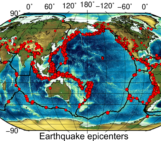
Every week, The Sassy Scientist answers a question on geodynamics, related topics, academic life, the universe or anything in between with a healthy dose of sarcasm. Do you have a question for The Sassy Scientist? Submit your question here or leave a comment below.
In a comment on a post about the key papers in geodynamics, the Curmudgeonly Commenter asked:
Could you please point out some exceptionally important papers in geodynamics and tell us something interesting about the history of the field?
Dear CC,
I can call you CC, right? To satisfy your needs, I’ll take on a topic that is unquestionably home to the geodynamics territory, but people are not always aware of the history behind it. I’ve chosen one that resides in the (relatively) short-timescale corner of possible topics, with many other fields contributing fundamental observations and processes: the earthquake cycle. After all, I have already discussed mantle and lithosphere dynamics at length.
The major contributions to understanding earthquakes in the past originated through several lines of inquiry with seismology, rock mechanics and geodesy providing a variety of observations. The latest contributions arise from numerical modelling (and sure… some analogue modelling too) with e.g. dynamic rupture modelling and the embedding of the earthquake cycle in long-term, evolutionary geodynamic models. To accommodate your desire for some historical provenance on the topic, these posts will be somewhat more serious than you’re used to. Bear in mind I still can only cover some aspects. Apparently, some people have thought about this over the past century… I’ll insist that at least the basics in this little story should be common understanding for those involved in the field of geodynamics. With this I mean… everyone! If that’s not the case for you, you’ve got some reading to do.
Now, I had prepared a lengthy post to impress you with my knowledge on all things earthquakes, but my …lovely… Editor-in-Chief stepped in and straight-out forbid me to publish it as it is (well, was). The nerve! Apparently she thinks people wouldn’t read long blog posts. I guess you would like to prove her wrong, right? Unfortunately, my hands are tied. As a faithful, but desperately subjugated, Sassy Scientist, the answer to your question is now split up into multiple posts. With a heavy heart, you’ll get to experience my response to your question over multiple weeks. Isn’t that fantastic? I know I think it is…
So, next week, I’ll actually start going in depth and teach you all abound elastic rebound and dislocation theory. You’re welcome.
Yours truly,
The Sassy Scientist
PS: This post was written reluctantly, despite another, well-written, just a wee bit longer, literary magnificent response to your question, CC. Do you like Editor-in-Chiefs as much as I do?
PS2: As Leonardo Da Vinci once said: “Nothing strengthens authority so much as silence.” I’ll thus shut up about this in the forthcoming series of posts.
PS3: However; “The Sassy Scientist remembers”. And also; “A Sassy Scientist always pays his debts”.
PS4: …




The Curmudgeonly Commenter
You sure put me in my place! Thanks!